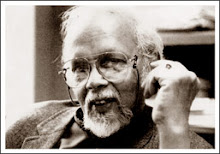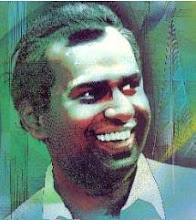Author: Indeewara Thilakarathne and Ranga Chandrarathne
Date:31/01/2011
Source: Sunday Observer
The existence of Sri Lankan ballet is polemical, although the genre of ballet has not evolved in Sri Lanka. For most of the art lovers, the world ballet remai ns alien in Sri Lankan context although it is popular in Russia, China and in many nations of the world.
For the new generation, 'ballet' is a word in the dictionary or in an encyclopedia which has a vague meaning. Perhaps, they have not seen a ballet being performed.
The same fate befell drama and to a certain extent Sinhala films too. However, it is not clear whether the present plight resulted from the alienation of audiences from Sinhalese ballet or whether the artists are unable to make their work relevant to the fast changing needs of the audience.
 Ballet in its original form is, somewhat, a strange medium to Sri Lankan audience which is used to watch plays full of dialogues.
Ballet in its original form is, somewhat, a strange medium to Sri Lankan audience which is used to watch plays full of dialogues.
For them ballet with music, dance and gesticulations would have been a strange medium. Still some spectators watch ballet for colourful costumes, personalities of actors and beautiful body movements and not for dramatic qualities. However, this is not the kind of dialogue and communication that ballet maintains with the audience.
The purpose of ballet is to create aesthetic feelings in the audience by means of music and body movements. It seems that Sri Lankan audience still finds it difficult to appreciate drama without traditional ingredients of dialogues, character portrayals and gesticulations.
However, ballet has been considered as a dramatic manifestation that creates zest among an audience. In a broader sense, ballet is an art form which creates a message by using music, movements, lighting and sets. The basic premise of ballet is to narrate a story.
History of ballet
Dance is prominent throughout history. Traditions of narrative dance evolved in China, India, Indonesia and Ancient Greece. However, theatrical dance was well-established in the wider world. In the last century, the United States also developed its own ballet traditions, most notably with choreographer George Balanchine.
Although interest in contemporary dance has expanded to include modern dance, jazz, flamenco and other forms, ballet has endured the test of time and is still taught and performed.
The etymology of the word "ballet" corresponds to the art form's development. It is a beautiful dance.
Choreography was adapted from court dance steps. Performers dressed in fashions of the times. For women it meant formal gowns that covered their legs to the ankle. Early ballet was participatory, with the audience joining the dance towards the end.
Engraving of the first scene of the Ballet Comique de la Reine. Domenico da Piacenza was one of the first dancing masters. Along with his students, Antonio Cornazano and Guglielmo Ebreo, he was trained in dance and responsible for teaching nobles the art. Da Piacenza left one work: De arte saltandi et choreus ducendi (On the art of dancing and conducting dances), which was put together by his students.
Ballet, if not the first, produced and shown was Balthasar de Beaujoyeulx's Ballet Comique de la Reine (1581) and was a ballet comique (ballet drama).In the same year, the publication of Fabritio Caroso's Il Ballarino, a technical manual on court dancing, both performance and social, helped to establish Italy as a centre of technical ballet development.
However, ballet is now being used to portray a religious concept or philosophical ideas in music and dance. And there are ballets consisting only music and dance (Plotless ballets).
Ballet has been developed as a serious art form in the West. Originally ballet depicted Western myths and fairy tales with simple plots. However, it has acquired complex nature by integration of diverse tradition of dancing as well as characteristics of other art forms.
The themes of ballet evolve from fairy tales, Shakespeare tragedies to world war, violence and feminism. It grammar of choreography is enriched by characteristics of Asian, African, Jazz and other music traditions.
The basis for the Sri Lankan ballet can be traced to the "Group Modern", a troupe that came to Sri Lanka in 1935 with Rabindranath Tagore.
A generation of Sri Lankan youth inspired by the performance went to India and learnt drama. Ballet developed in Sri Lanka from the 1940's along with the Indian dance drama.
 The influence of Indian dance drama was a marked characteristic in early Sri Lankan ballets. However, this was changed with Premakumara Epitawala" Sala Lihini Sandeshaya". It was closer to a musical drama than to a ballet.
The influence of Indian dance drama was a marked characteristic in early Sri Lankan ballets. However, this was changed with Premakumara Epitawala" Sala Lihini Sandeshaya". It was closer to a musical drama than to a ballet.
Sri Lankan ballet assumed character and stature with Chithrasena's production of "Karadiya" in 1961. Chithrasena's "Nala Damayanth" and Karadiya showed mix characteristics of indigenous, Indian and Western traditions of drama.
They are considered as first ever Sri Lankan ballets. Chithrasena's subsequent works such as "Kinkini Kolama" (based on low country dancing) and "Shiva Ranga" can be considered as researches which depicted characteristics of Kolam, humour as well as to a certain extent alienation of audience with the characters of the ballet.
Though "Shiva Ranga" is based on Indian legend, it has not stuck to Indian dance drama style but used modern style of ballet. The style is a result of a combination of Indian and Western abstract ballet styles. Contribution made by Premakumar Epitawala, Shesha Palihakkara and Basil Mihiripenna should also be appreciated as important steps towards establishing Sri Lankan ballet.
Not reacting to the new trends in Sri Lankan, audience which was gradually shifted from appreciating serious form of art like ballet to cheap movements of dance , music and cheap romance, has also been contributed to the isolation of ballet in Sri Lanka. Ballet has not been considered as a serious form of art with Sri Lankan characteristics. Although new generation of choreographers tried had to resurrect the dying tradition, their attempts have not been received due attention.
These young dramatists tried , especially to produce short ballets; Greek Tragedies, Shakespearean drama, Japanese drama, Biblical stories as well as short ballets on themes of war, prisoners of war, ethnic strife, homosexual issues and religious contradictions.
The total isolation of Ballet in Sri Lanka is a clear indication of the deteriorating standards of literary criticisms and critics as well as the lowering public taste. Sri Lankan audience is increasingly relied upon flash music and cheap soap operas telecast over television.
In order to revive Sri Lankan tradition of ballet, it is imperative that ballet should be offered its due place. It is also necessary to launch a re-education programme from school to universities, with a view to create an informed audience.




































No comments:
Post a Comment